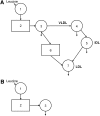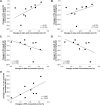Effects of Therapeutic Lifestyle Change diets high and low in dietary fish-derived FAs on lipoprotein metabolism in middle-aged and elderly subjects
- PMID: 22773687
- PMCID: PMC3413235
- DOI: 10.1194/jlr.P024315
Effects of Therapeutic Lifestyle Change diets high and low in dietary fish-derived FAs on lipoprotein metabolism in middle-aged and elderly subjects
Abstract
The effects of Therapeutic Lifestyle Change (TLC) diets, low and high in dietary fish, on apolipoprotein metabolism were examined. Subjects were provided with a Western diet for 6 weeks, followed by 24 weeks of either of two TLC diets (10/group). Apolipoprotein kinetics were determined in the fed state using stable isotope methods and compartmental modeling at the end of each phase. Only the high-fish diet decreased median triglyceride-rich lipoprotein (TRL) apoB-100 concentration (-23%), production rate (PR, -9%), and direct catabolism (-53%), and increased TRL-to-LDL apoB-100 conversion (+39%) as compared with the baseline diet (all P < 0.05). This diet also decreased TRL apoB-48 concentration (-24%), fractional catabolic rate (FCR, -20%), and PR (-50%) as compared with the baseline diet (all P < 0.05). The high-fish and low-fish diets decreased LDL apoB-100 concentration (-9%, -23%), increased LDL apoB-100 FCR (+44%, +48%), and decreased HDL apoA-I concentration (-15%, -14%) and PR (-11%, -12%) as compared with the baseline diet (all P < 0.05). On the high-fish diet, changes in TRL apoB-100 PR were negatively correlated with changes in plasma eicosapentaenoic and docosahexaenoic acids. In conclusion, the high-fish diet decreased TRL apoB-100 and TRL apoB-48 concentrations chiefly by decreasing their PR. Both diets decreased LDL apoB-100 concentration by increasing LDL apoB-100 FCR and decreased HDL apoA-I concentration by decreasing HDL apoA-I PR.
Figures


References
-
- Grundy S. M., Cleeman J. I., Merz C. N., Brewer H. B., Jr, Clark L. T., Hunninghake D. B., Pasternak R. C., Smith S. C., Jr, Stone N. J. 2004. Implications of recent clinical trials for the National Cholesterol Education Program Adult Treatment Panel III guidelines. Circulation. 110: 227–239. - PubMed
-
- Adult Treatment Panel III. 2001. Executive Summary of the Third Report of the National Cholesterol Education Program (NCEP) Expert Panel on Detection, Evaluation, and Treatment of High Blood Cholesterol in Adults. J. Am. Med. Assoc. 285: 2486–2497. - PubMed
-
- Krauss R. M., Eckel R. H., Howard B., Appel L. J., Daniels S. R., Deckelbaum R. J., Erdman J. W., Jr, Kris-Etherton P., Goldberg I. J., Kotchen T. A., et al. 2000. AHA Dietary Guidelines: revision 2000: A statement for healthcare professionals from the Nutrition Committee of the American Heart Association. Circulation. 102: 2284–2299. - PubMed
-
- Berglund L., Lefevre M., Ginsberg H. N., Kris-Etherton P. M., Elmer P. J., Stewart P. W., Ershow A., Pearson T. A., Dennis B. H., Roheim P. S., et al. 2007. Comparison of monounsaturated fat with carbohydrates as a replacement for saturated fat in subjects with a high metabolic risk profile: studies in the fasting and postprandial states. Am. J. Clin. Nutr. 86: 1611–1620. - PubMed
-
- Vincent-Baudry S., Defoort C., Gerber M., Bernard M. C., Verger P., Helal O., Portugal H., Planells R., Grolier P., Amiot-Carlin M. J., et al. 2005. The Medi-RIVAGE study: reduction of cardiovascular disease risk factors after a 3-mo intervention with a Mediterranean-type diet or a low-fat diet. Am. J. Clin. Nutr. 82: 964–971. - PubMed
Publication types
MeSH terms
Substances
Grants and funding
LinkOut - more resources
Full Text Sources
Other Literature Sources
Research Materials
Miscellaneous

